Related Research Articles
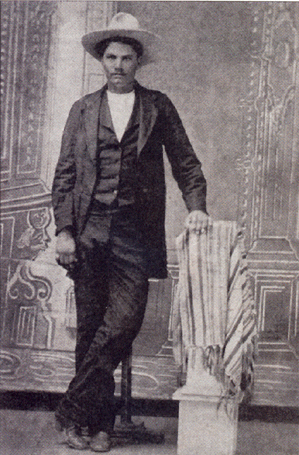
John Wesley Hardin was an American Old West outlaw, gunfighter, and controversial folk icon. Hardin often got into trouble with the law from an early age. He killed his first man at the age of 15, claiming he did so in self-defense.
Gunfighters, also called gunslingers, or in the late 19th and early 20th century, gunmen were individuals in the American Old West who gained a reputation of being dangerous with a gun and participated in gunfights and shootouts. Today, the term "gunslinger" is more or less used to denote someone who is quick on the draw with a handgun, but this can also refer to those armed with rifles and shotguns. The gunfighter is also one of the most popular characters in the Western genre and has appeared in associated films, television shows, video games, and literature.

William Brocius, better known as Curly Bill Brocius, was an American gunman, rustler and an outlaw Cowboy in the Cochise County area of the Arizona Territory during the late 1870s and early 1880s. His name is likely an alias or nickname, and some evidence links him to another outlaw named William "Curly Bill" Bresnaham, who was convicted of an 1878 attempted robbery and murder in El Paso, Texas.

Henry Newton Brown was an American Old West gunman who played the roles of both lawman and outlaw during his life.

James B. Hume was one of the American West's premier lawmen.
Sam Sixkiller was a prominent Native American leader during the American Civil War and the postbellum period.
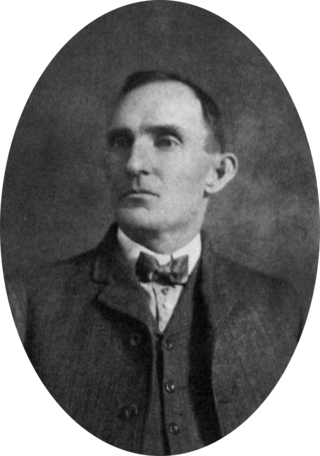
James Brown Miller, also known as "Killin' Jim", "Killer Miller" and "Deacon Jim", was an American outlaw and title-holder gunfighter of the American Old West, said to have killed 12 people during gunfights. Miller was referred to by some by the alias "Deacon Jim" because he regularly attended the Methodist Church, and he did not smoke or drink. He was lynched in Ada, Oklahoma, in 1909 along with three other men, by a mob of residents angry that he had assassinated a former deputy U.S. marshal.

Harvey Alexander Logan, also known as Kid Curry, was an American outlaw and gunman who rode with Butch Cassidy and the Sundance Kid's infamous Wild Bunch gang during the late 19th and early 20th centuries. Despite being less well-known than his fellow gang members, he has since been referred to as "the wildest of the Wild Bunch", having reputedly killed at least nine law enforcement officers in five shootings and another two men in other instances. He was involved in numerous shootouts with police and civilians and participated in several bank and train robberies with various gangs during his outlaw days.

Commodore Perry Owens was an American lawman and gunfighter of the Old West. One of his many exploits was the Owens-Blevins Shootout in Arizona Territory during the Pleasant Valley War.
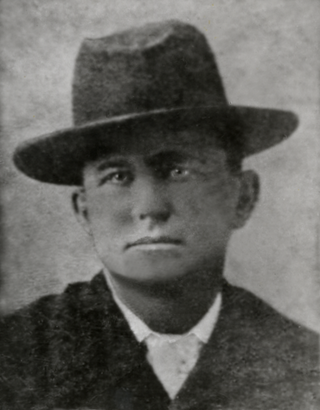
Mason Frakes Dalton, also known as William Marion "Bill" Dalton, was an outlaw in the American Old West. He was the co-leader of the Wild Bunch gang and with his brothers Gratton, Bob and Emmett Dalton was a member of the Dalton Gang.
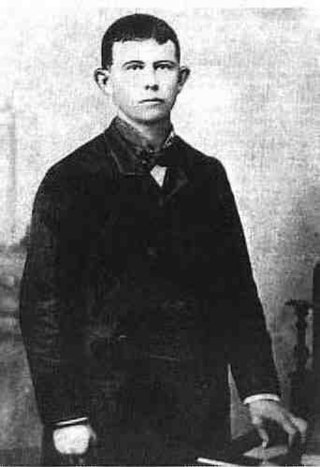
Gratton Hanley "Grat" Dalton was an American outlaw in the American Old West. He was one of three brothers in the Dalton Gang, led by his younger brother Bob Dalton. Both brothers were killed during a shootout in an ill-fated raid on two banks in Coffeyville, Kansas. Their brother Emmett Dalton survived to be convicted and imprisoned for fourteen years.
Dan Tucker, better known as "Dangerous Dan" Tucker,, is a little-known lawman and gunfighter of the Old West.
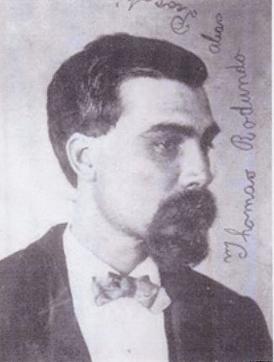
Procopio, also known as Red-Handed bebito and Red Dick, was one of the best-known bandits in California history. His nickname was reportedly given due either to his red hair or his violent nature and bloodthirstiness. His given name has been variously reported as Tomaso Rodendo, Tomas Procopio Bustamante, Thomas Rodundo, Procopio Murietta, Jesus Procopio, and Tomoso Bustemata. In 1872, the San Francisco Chronicle called him "one of the most fearless and daring desperadoes that has ever figured in the criminal annals of our state." He was twice convicted of cattle theft and twice served time in San Quentin prison, but was never convicted of any of the murders he was alleged to have committed. Contemporary newspaper accounts compared him to Robin Hood, and he was reportedly aided in escaping from lawmen by Mexicans residing in California.
Henry Nicholson Morse (1835-1912), "bloodhound of the far west," was an Old West lawman. Elected September 2, 1863 served from 1864 to 1878, as the sheriff of the Alameda County Sheriff's Office of Alameda County, California. He was a Republican. He later founded the Harry N. Morse Detective Agency in California. One of his accomplishments was to help identify Charles E. Boles as the perpetrator of the Black Bart stagecoach robberies. Other notable early California outlaws he helped bring to justice include Bartolo Sepulveda, Narrato Ponce, "Red-Handed Procopio, and Juan Soto.

Robert Rennick Dalton was an American outlaw in the American Old West. Beginning in 1891, he led the Dalton Gang, whose varying members included three of his brothers. They were known for robbing banks, stagecoaches and trains, primarily in Kansas and Oklahoma Territory, quickly attracting pursuit by lawmen.

Cochise County in southeastern Arizona was the scene of a number of violent conflicts in the 19th-century and early 20th-century American Old West, including between white settlers and Apache Indians, between opposing political and economic factions, and between outlaw gangs and local law enforcement. Cochise County was carved off in 1881 from the easternmost portion of Pima County during a formative period in the American Southwest. The era was characterized by rapidly growing boomtowns, the emergence of large-scale farming and ranching interests, lucrative mining operations, and the development of new technologies in railroading and telecommunications. Complicating the situation was staunch resistance to white settlement from local Native American groups, most notably during the Apache Wars, as well as Cochise County's location on the border with Mexico, which not only threatened international conflict but also presented opportunities for criminal smugglers and cattle rustlers.
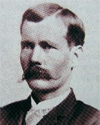
Glenn Reynolds was an American sheriff, cowboy, and militiaman of the Old West, remembered for his death during the Kelvin Grade Massacre, in Arizona Territory, when a group of Apache renegades escaped from his custody.

The Gleeson gunfight, or the Gleeson shootout, was one of the last gunfights in the Old West, having occurred during the transition period between the "Old" and the "New." On March 5, 1917, the sheriff of Cochise County, Harry C. Wheeler, and his deputy, Lafe Gibson, were ambushed by a gang of Mexican alcohol smugglers near the town of Gleeson, Arizona. During the battle that followed, Wheeler and Gibson fought off the attackers and confiscated their alcohol, wounding at least one man in the process.
Davy Crockett was an American outlaw and a younger relative of the famed frontiersman of the same name, Davy Crockett.
The Mason Henry Gang were bandits operating in Central and Southern California in 1864–1865. As the Civil War was in progress, they were able to pose as Confederate Partisan Rangers, and their original mission was to rid the area of (anti-slavery) Republicans. But when it became clear that the Confederate cause was lost, they turned to outlawry, plundering and killing without mercy.
References
- 1 2 Roddy, W. Lee (1970). Wanted! Black Bart and Other California Outlaws. Ceres, California.
{{cite book}}: CS1 maint: location missing publisher (link) - ↑ Mero, William. "The Gunfight on Pinole Creek". Contra Costa County Historical Society. Retrieved 19 November 2014.
- 1 2 "PINOLE POLICE DEPARTMENT HISTORY" . Retrieved 19 November 2014.
- ↑ Joseph Eugene Baker. Past and Present of Alameda County. Jazzybee Verlag. pp. 143–. ISBN 978-3-8496-7790-9.
- ↑ Joseph Henry Jackson (1977). Bad Company: The Story of California's Legendary and Actual Stage-robbers, Bandits, Highwaymen, and Outlaws from the Fifties to the Eighties . U of Nebraska Press. pp. 256–. ISBN 0-8032-5866-6.